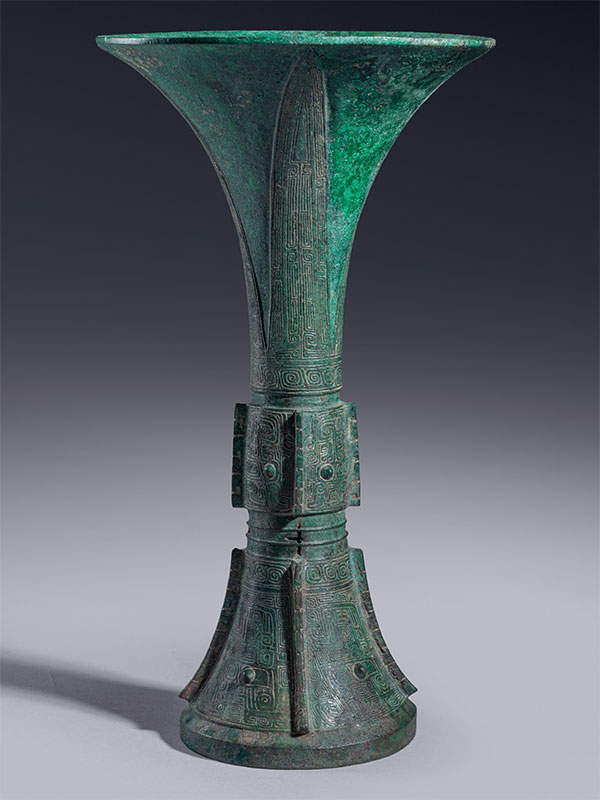Bronze ritual beaker, Gu
China, late Shang dynasty, Anyang phase, 12th – 11th century B.C.
An archaic bronze beaker, the flared base section supported on a straight foot, the tall neck gradually widening to a trumpet mouth. The body is divided into three sections. The lower and middle sections each have four notched flanges, which divide into four panels the decoration of paired dragons on a ground of spirals. The dragons, when viewed in pairs, form large taotie masks with prominent, bulging eyes. The top section is decorated with four vertical leaf ornaments. Between the central and lowers section, four cruciform apertures can be seen. The gu is covered in a greenish patina, with more pronounced malachite colouring to the top section and interior.
Together with the tripod pouring vessel, jue, the slender chalice-like beaker known as gu is one of the oldest forms in the repertory of archaic bronze vessels. The term gu was given to this type of beaker in the Song dynasty (960 – 1279 AD); it does not appear in ancient texts. The four banana-leaves that decorate the top section of the vessel are a decorative innovation of the late Shang dynasty, probably of the Anyang phase. The shape of this vessel is particularly elegant and it also has a very attractive malachite patina. Similar gu are in the Arthur M.Sackler Collection[1], in the Musée Guimet[2], in the Rietberg Museum[3], in the Shanghai Museum[4], and in the Museum of Decorative Art, Copenhagen[5].
Provenance:
Ben Janssens Oriental Art, July 2002
Private Collection, UK
- Bagley, R.W. Shang Ritual Bronzes in the Arthur M. Sackler Collections, Washington D.C. 1987, nos. 34&35, 36, pp. 244-249
- Deydier, C. Archaic Chinese Bronzes, 1995,Vol. I Xia – Shang, plate 1, p. 226
- Op cit, no. 2, p. 226
- Ancient Chinese Bronze Vessels from the Li Yingshuan Collection, Shanghai 1996, plate 2, p. 145
- Leth, A. Catalogue of Selected Objects of Chinese Art in the Museum of Decorative Art, Copenhagen, Copenhagen 1959, no. 8

